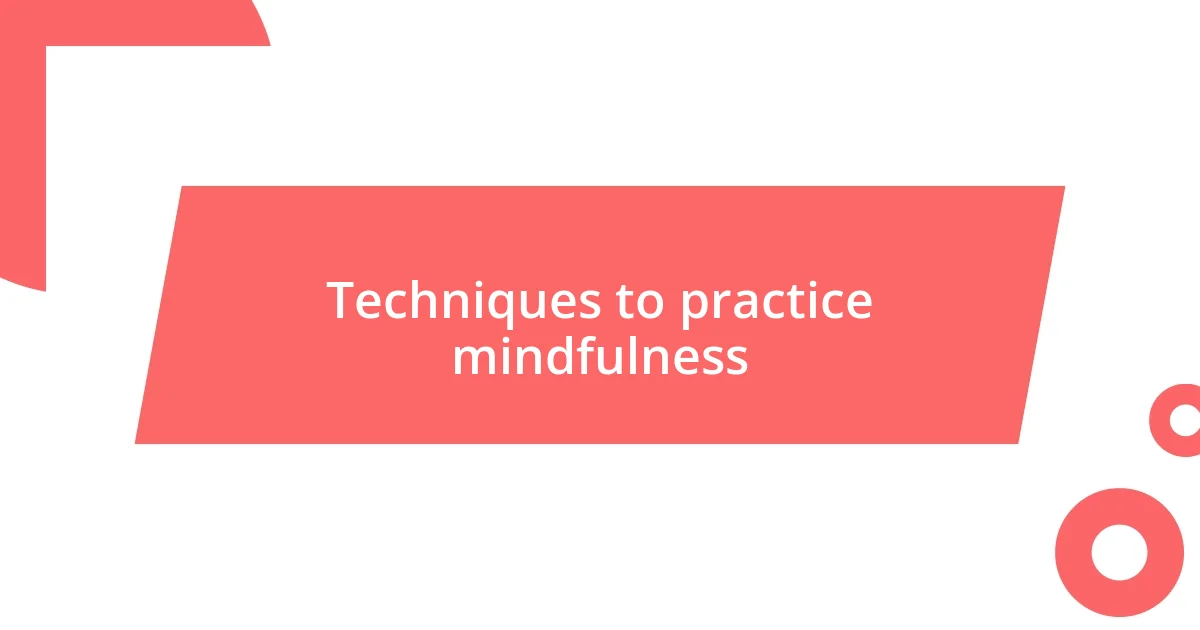Key takeaways:
- Mindfulness enhances training by fostering mental focus, emotional awareness, and a deeper mind-body connection, transforming workouts into purposeful experiences.
- Incorporating techniques such as focused breathing, body scans, and visualization not only improves performance but also reduces anxiety and promotes resilience.
- Evaluating the impact of mindfulness reveals significant shifts in perspective towards fitness, emphasizing self-awareness and the quality of training over mere results.

Understanding mindfulness in training
Mindfulness in training goes beyond just physical preparation; it intertwines mental focus and emotional awareness into the process. I remember my first experience with mindfulness techniques during a particularly challenging workout. As I focused on my breath and the sensations in my body, I found a sense of calm that allowed me to push through fatigue—an experience that forever changed how I approached training.
Have you ever finished a training session and felt mentally drained? I certainly have. Mindfulness helps bridge the gap between the physical and mental realms. By incorporating practices like deep breathing and body scans into my routine, I learned to tune in to my thoughts and emotions, allowing me to process any stressors that might impact my performance. This shift not only enhanced my focus but also brought a level of clarity I had never experienced before.
Often, people mistake mindfulness for a mere relaxation technique, but it’s much more profound. It’s about being present and engaged in the moment, especially during grueling training sessions. In my case, facing my racing thoughts head-on—acknowledging them without judgment—transformed my workouts from mindless routines into purposeful journeys. When you truly understand mindfulness, you discover the empowerment that comes from heightened awareness and intention. What might you uncover about yourself through this practice?

Benefits of mindfulness in training
Mindfulness in training offers a wealth of benefits that can significantly enhance performance. For instance, by incorporating mindful practices, I noticed an improvement in my ability to stay present during workouts. This heightened awareness not only allowed me to push my limits but also helped me recognize when I needed to adjust my approach, ultimately leading to better results.
Another remarkable advantage I found is the reduction of anxiety and stress associated with training. There was a time when the pressure to perform consistently left me overwhelmed. However, by integrating mindfulness techniques such as visualization and positive affirmations, I began to transform my mindset. Those techniques fostered resilience, allowing me to face challenges with a sense of calm and confidence that I hadn’t experienced before.
Furthermore, mindfulness nurtures a deeper connection between the mind and body. I vividly recall a session where I was struggling with an exercise that usually felt easy. Instead of becoming frustrated, I paused and focused on my breath, tuning into my body’s signals. This practice revealed not just physical fatigue but also underlying tension I hadn’t acknowledged. By responding thoughtfully to these cues, I improved my technique and avoided injury, proving how pivotal mindfulness can be in training.
| Benefits | My Experience |
|---|---|
| Enhanced Focus | Allowed me to push limits and recognize the need for adjustments. |
| Reduced Anxiety | Transformed mindset through visualization and positive affirmations. |
| Mind-Body Connection | Helped me realize underlying tension and improve technique to avoid injury. |

Techniques to practice mindfulness
When it comes to practicing mindfulness, I’ve found that a variety of techniques work wonders, each with its unique benefits. One practice that really resonated with me is focused breathing. Before diving into a workout, I take a few moments to concentrate solely on my breath—inhales through my nose and exhales through my mouth. This simple act grounds me and sets a focused intention for my training session, making me feel present and ready to tackle any challenge.
Here are some effective mindfulness techniques I’ve personally integrated into my training routine:
- Focused Breathing: Concentrate on your breath to center your thoughts.
- Body Scans: Gradually check in with different body parts to release tension.
- Mindful Walking or Jogging: Pay close attention to each step and the environment.
- Visualization: Picture your goals or successful performance to enhance motivation.
- Gratitude Journaling: Reflect on what you’re thankful for after each session to foster positivity.
One day, I was feeling particularly restless before my training. Instead of pushing through without addressing my mental state, I decided to try a body scan. Lying on the mat, I systematically brought attention to each muscle group. To my surprise, I discovered tightness in areas I hadn’t even realized were tense. The release that followed was astonishing; it not only improved my focus but also opened up my range of motion. Integrating these techniques into my training does more than just enhance performance—it creates a richer, more fulfilling experience.

Incorporating mindfulness into workouts
Incorporating mindfulness into workouts truly transformed my approach to training. I remember one particularly challenging day when I was lifting weights. Instead of just going through the motions, I took a moment to close my eyes and visualize each lift. This mindfulness practice allowed me to connect with my body, feel the muscles working, and even notice the slight shifts in balance. Who knew simply being present could make such a difference?
When I’m out for a run, I often catch myself getting lost in thoughts about the day ahead. However, I found that tuning into my breath and the rhythm of my footsteps makes the experience so much richer. I still recall the feeling of the wind on my face and the ground beneath my feet. It was exhilarating to shift my focus from just finishing the distance to actually enjoying the journey. Isn’t it fascinating how a simple mindset shift can turn a routine workout into a meditative escape?
On days when motivation wanes, I challenge myself to incorporate mindfulness by creating a “mindful minute” at the start of each session. This means taking just one minute to express gratitude for my body and its capabilities. I vividly remember a session where I felt particularly sluggish, but after this brief moment of reflection, my energy surged. It made me wonder: how often do we take a moment to appreciate ourselves? This tiny shift not only elevates my workouts but also helps me cultivate a deeper respect for my physical journey.

Creating a mindful training routine
Creating a mindful training routine begins with intentionally setting aside time to connect with yourself before every workout. For instance, I remember one morning feeling overwhelmed by the day’s tasks ahead. Rather than rushing into my usual routine, I decided to dedicate those first ten minutes to simply sitting quietly, feeling the ground beneath me, and tuning into the sensations of my body. This practice of grounding not only calmed my mind, but it also made the workout itself feel more purposeful and engaging.
As the weeks went on, I noticed that each training session seemed to flow into the next with greater ease. I began incorporating a short reflection period after my workouts where I journaled my emotions and physical sensations. One day, after an especially intense session, I wrote about a fleeting moment of doubt I felt during the final set. Scribbling it down made all the difference; I transformed a nagging worry into a stepping stone for growth. I often ask myself, “What other insights might I unearth by simply pausing to reflect?” And, honestly, the answers have been invaluable.
I also try to embrace the concept of “intentional movement” throughout my training. Instead of going through the motions, I focus on the purpose behind each movement. During yoga, I remember a moment when I was transitioning between poses and found myself losing my balance. Instead of getting frustrated, I took a deep breath, re-centered, and visualized the fluidity of the pose. That shift made my practice feel more like a dance than a workout. How often do we forget that training can be both a physical and emotional journey? By choosing to integrate mindfulness, I’ve turned my sweat sessions into a holistic practice that nurtures both body and mind.

Overcoming challenges with mindfulness
Overcoming challenges with mindfulness requires a shift in perspective, especially when faced with setbacks. I recall a time during a high-intensity interval training session when my mind began to spiral into negative thoughts, telling me to quit. Instead of succumbing, I paused to take three deep breaths, focusing on the sensation of the air filling my lungs. This simple act not only grounded me but also reminded me that perseverance is just as much a mental game as it is physical.
In moments where anxiety threatens to overshadow my training, I’ve found it vital to practice self-compassion. One particularly tough day, I struggled to keep pace during a long run, feeling frustrated with each step. Rather than berating myself, I allowed the feeling of disappointment to wash over me, acknowledging it without judgment. By embracing those emotions, I transformed that run into a lesson about resilience. Isn’t it liberating to realize that our struggles can sometimes reveal our strengths?
Mindfulness also plays a key role in maintaining focus amidst distractions. I remember a time in the gym when loud music and chatter pulled me away from my workout. Instead of getting distracted, I closed my eyes and directed my attention back to my breath—deep, steady, and calming. This practice not only sharpened my concentration but made me appreciate the surrounding chaos, reminding me that I could be in control of my experience. How often do we allow external noise to drown out our inner dialogue? By taking a moment to recenter, I’ve learned that I hold the power to turn challenges into opportunities for growth.

Evaluating the impact of mindfulness
Evaluating the impact of mindfulness in my training journey has been nothing short of transformative. One day, after a particularly grueling workout, I sat down to assess how my newfound practice had changed my perspective on fitness. Instead of focusing solely on the physical exhaustion, I reflected on how I felt mentally—more balanced and less overwhelmed. I often wonder: what if we all took a moment to acknowledge the positive mental shifts in our training?
When I compare my pre-mindfulness days to now, I see a significant difference in my performance and emotions. There was a time when my workouts were purely results-driven; I chased numbers relentlessly. Now, they’re infused with intention, creating space for self-awareness and joy. I’ve even started measuring success by the quality of my sessions rather than just the duration. How liberating is that? It’s a gentle reminder that genuine progress can come from within, not just from the outside.
I also noticed that employing mindfulness techniques helped me recover faster, both physically and emotionally. After a tough session, I could feel the familiar post-workout fatigue settling in. Instead of diving straight into recovery routines, I dedicated a few moments to notice how my body felt. This simple pause not only alleviated my soreness but filled me with gratitude for what my body could achieve. Isn’t it incredible how mindfulness can shift our relationship with our workouts, making us more attuned to our needs?















